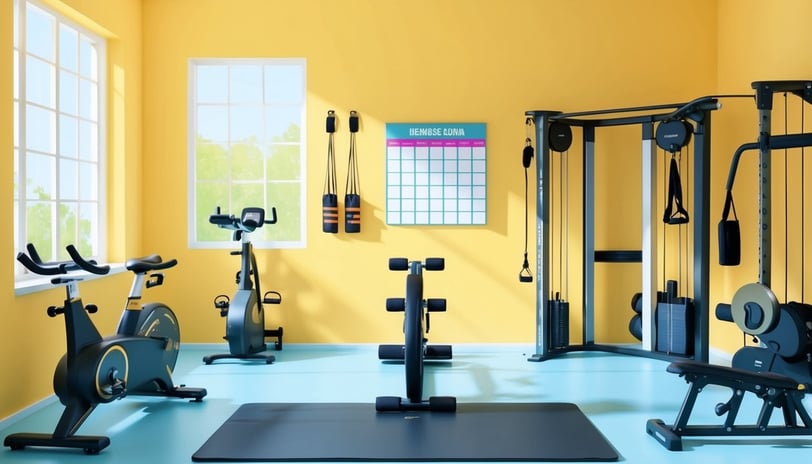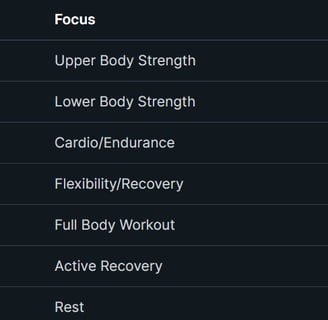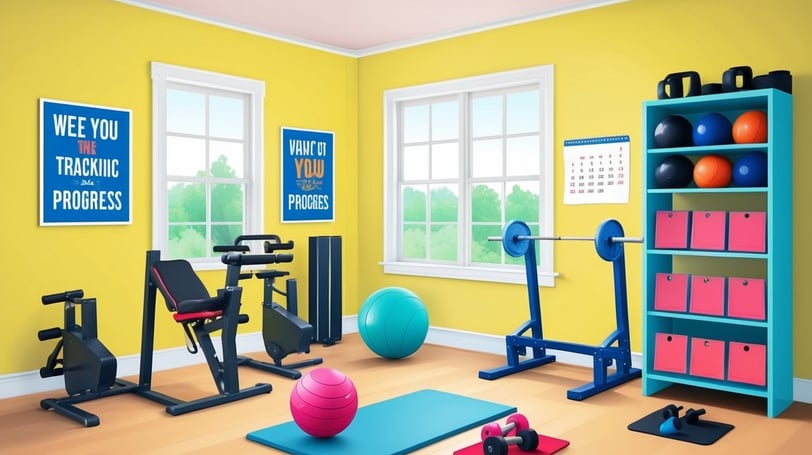Personalized Home Workout Schedule: Maximize Results in Minimal Time
Learn to create a personalized home workout schedule that delivers maximum results. Explore expert tips to enhance your fitness journey and stay on track.
FITNESS
2/10/20256 min read


How to Create a Home Workout Schedule for Maximum Results: Simple Tips for Your Fitness Journey
Creating a workout schedule at home can feel like a daunting task, but it doesn’t have to be. With a clear plan tailored to fit your needs, you can achieve impressive results right in your living room. I’ve found that a structured routine not only keeps me on track but also injects excitement into my fitness journey. By setting aside specific days and times for exercise, I’ve noticed a remarkable increase in my motivation and consistency.
When I started designing my personalised workout plan, I focused on what equipment I had available, like resistance bands and dumbbells, and built my regimen around that. Incorporating a mix of strength training and cardio helped me stay engaged. Plus, keeping track of my progress allowed me to celebrate small victories, which spurred me on even more.
In this post, I’ll share effective strategies to help you create a home workout schedule that works for you. Whether you're a beginner or someone looking to refine your routine, these tips will lighten the load of planning and keep you motivated throughout your fitness journey.
Key Takeaways
A structured workout schedule boosts motivation and consistency.
Personalising your workout plan makes fitness more engaging.
Tracking progress helps celebrate achievements along the way.
Designing Your Personalised Workout Plan
Creating a personalised workout plan can be a game changer for your fitness journey. By focusing on your unique goals and fitness level, you can maximise your results and enjoy your workouts more. Let's explore how to build a plan that works for you.
Assessing Your Fitness Level
Before diving into a workout plan, I take a moment to assess my fitness level. This means being honest about where I am right now. I consider my endurance, strength, and flexibility.
To gauge my abilities, I often use simple tests. For example, how many push-ups can I do in one go? What about running for 1 kilometre? I note down these figures, as they help me choose exercises that suit my current skill set and avoid injury.
Goal Setting for Success
Setting clear fitness goals is essential. I always think about what I want to achieve: Is it weight loss, muscle gain, or improving my endurance? By defining my goals, I stay focused.
For instance, I might set short-term goals, like increasing my squat weight by 5 kg over the next month. This gives me something concrete to work towards. I keep my goals realistic and measure progress regularly, adjusting my plan if needed.
Crafting a Balanced Routine
A balanced routine is vital for working different muscle groups and avoiding overuse injuries. I ensure my workout plan includes exercises for the upper body, lower body, and core.
Here's a quick example of how I might structure my week:
This way, I target all major muscle groups while allowing time for recovery.
Creating a Weekly Schedule
I find that having a structured workout schedule helps me stay on track. I block out time for each session in my calendar, making it a priority.
Each week, I divide my workouts based on my goals and fitness level. For example, if I want to focus on strength, I might do three strength sessions, adding cardio on rest days. I always listen to my body and adjust my schedule to ensure I’m not overdoing it.
Incorporating Variety and Flexibility
Keeping things fresh is important for staying motivated. I often mix up exercises and include different equipment, like dumbbells or resistance bands.
I also try to add new activities, such as yoga or swimming, which helps with flexibility and keeps the routine enjoyable. If one week seems intense, I might adjust the reps or sets to accommodate my energy levels.
By being flexible and creative, I maintain my interest and commitment to my personalised workout plan. For added inspiration, I often look at workout gear on Amazon UK for both men and Women to find new tools and resources to enhance my sessions.
Effective Home Workout Strategies
Creating an effective home workout schedule is all about making smart choices. I’ve discovered several strategies that help me maximise gains while staying motivated.
Gather Your Equipment
You don’t need a fully equipped home gym to get great results. Start simple and add as needed. Here are some basics:
No Equipment Required: Use your body weight for exercises like push-ups, squats, and planks.
Optional Equipment:
A yoga mat for comfort
Resistance bands for strength training
Dumbbells or kettlebells for added intensity
A jump rope for cardio
A sturdy chair for tricep dips or step-ups
Having the right equipment can expand your workout possibilities, but remember—it’s not mandatory. Consistency trumps fancy gear!
Maximising Strength and Muscle Growth
To build strength and muscle, I focus on progressive overload. This means gradually increasing the weight or resistance in my workouts. I like using free weights or resistance bands at home. I set a goal to complete 3-4 sets of 8-12 reps for each exercise.
Incorporating various exercises is key. I choose compound movements like squats, deadlifts, and push-ups. These work multiple muscle groups, providing a better overall workout. By mixing up my exercises every few weeks, I keep my routine fresh and exciting. It’s amazing how these small changes can lead to significant progress.
Combining Cardio and Strength Training
I find that balancing cardio and strength training is essential for overall fitness. I schedule cardio sessions 2-3 times a week, mixing in HIIT and steady-paced activities. For HIIT, I set a timer for work and rest intervals, like 30 seconds of sprinting followed by 30 seconds of walking. It keeps my heart rate up and boosts my metabolism.
I often pair strength training and cardio in a single workout. For example, I do a strength exercise, like dumbbell presses, followed by a quick cardio burst, like jumping jacks. This method keeps my workouts dynamic and pushes me to improve my endurance while building strength.
Recovery and Avoiding Overtraining
Recovery is a crucial aspect that I sometimes overlook. I make sure to have at least one full rest day each week. These days are vital for muscle recovery and growth. I also incorporate active recovery, like gentle stretching or yoga, to keep my body moving without intense strain.
Listening to my body is important. If I feel fatigued or sore, I adjust my routine. Overtraining can lead to burnout and injury, so I plan my workouts with built-in rest periods. This way, I maintain my enthusiasm and stay committed to my goals.
Utilising Technology and Apps
Leveraging fitness apps has transformed my workout life. I use apps to track my progress, log my workouts, and set goals. Many apps offer guided workouts, which are great when I need inspiration or want to try something new.
Some of my favourite apps provide exercise selection with videos, ensuring I maintain proper form. I also use reminders to keep my workouts consistent. By setting notifications, I stay accountable and keep my focus on my fitness journey.
Staying Motivated and Tracking Progress
Staying motivated during a home workout journey requires a mix of setting specific goals and creating an environment that supports your fitness ambitions. Tracking progress through various methods can keep your spirits high as you aim for your objectives.
Setting and Reviewing Goals
Setting clear fitness goals is essential. I like to break my goals into short-term and long-term categories. For instance, a short-term goal might be to work out three times a week for a month, while a long-term goal could involve losing a specific amount of weight or gaining muscle over six months.
I keep a workout journal to track my progress. Writing down achievements not only holds me accountable but also allows me to see how far I’ve come. Regularly reviewing these goals helps me adjust my plan. If I see I'm not making progress, I can reassess and adapt my approach to ensure I stay on track.
Creating a Supportive Environment
A supportive environment is crucial for maintaining motivation. I created my workout space at home, which is free from distractions. It’s inviting and equipped with everything I need, from dumbbells to yoga mats.
Having a workout buddy can make a big difference. Sharing my journey with a friend helps keep my spirits high on tough days. We encourage each other and share tips on nutrition and workouts. Whether virtual or in person, a support system can significantly enhance commitment to our fitness goals.
The Role of Quality Sleep and Nutrition
Quality sleep and proper nutrition profoundly impact my motivation and performance. I aim for 7-9 hours of sleep each night to ensure my body recovers well. If I don’t sleep enough, I often feel sluggish and demotivated.
Nutrition is just as important. I pay attention to my calorie intake and balance my meals with proteins, carbs, and healthy fats to support muscle gains and fat loss. I’ve found that meal prepping recipes make it easier to stay on track. Healthy snacks and balanced meals keep my energy levels up and my body ready for workouts.
I’ve also discovered some excellent fitness trackers on Amazon that help monitor my activity and sleep patterns. These tools remind me of my goals and encourage me every day!






